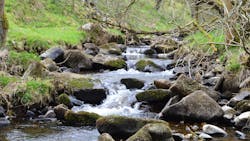USDA to invest $420M in 132 watershed projects
The U.S. Department of Agriculture (USDA) has announced that it will invest $420 million in 132 watershed infrastructure projects in 31 states.
The funded projects include rehabilitating dams, flood prevention, and watershed restoration. The investments are funded by the Infrastructure Investment and Jobs Act (IIJA) and build on a $166 million investment announced earlier this year.
Agriculture Secretary Tom Vilsack and White House Infrastructure Coordinator Mitch Landrieu made the announcement in Albany, Ga., as part of the Building a Better America Rural Infrastructure Tour. In Albany, the USDA Natural Resources Conservation Service (NRCS) is helping improve the flow of Radium Springs. Radium Springs does not flow consistently and is highly dependent on underground water.
Funds from the IIJA will be used to implement strategies that blend efficient irrigation methods with better resource management to ensure consistent flow to support agriculture, provide wildlife habitat, improve water quantity and quality, and improve the recreational value within the existing public park. Over $69 million will go towards eight projects that will provide relief for flood related watershed concerns.
“Our watershed programs help communities rebuild after natural disasters and prepare for future events,” Vilsack said in a press release. “This includes communities that we’ve historically underserved.”
The infrastructure announcement includes funding through two programs: the Watershed and Flood Prevention Operations (WFPO) Program, which provides technical and financial assistance for new watershed infrastructure, and the Watershed Rehabilitation Program (REHAB), which upgrades existing NRCS dams.
The Albany project is funded through WFPO. Additional examples of WFPO projects funded through the investment announced today include:
- The City of Pine Bluff, Ark.: Over the past five years, flooding has caused significant problems for both humans and property in Pine Bluff. Funding will be used to explore solutions, from design to construction, that will eliminate flooding issues that have impacted the safety, health and quality of life of its citizens.
- Tumalo, Owyhee and East Fork Irrigation Districts Modernization Projects, Ore.: Modernization provides a climate resilient solution to offset the impact of drought throughout the regions of Deschutes River, Tumalo Creek, Snake River, and Hood River watersheds. Open irrigation canals will be converted to pipe delivering water in a more efficient manner and preserving water where it is needed to restore critical habitat for designated trout and salmon species. Pipe conveyance conserves water by reducing loss from evaporation and seepage, diverts less water from rivers, and increases flow downstream.
Examples of REHAB projects include:
- Settingdown Creek Dam 54 & 56 – Forsyth County, Ga.: Both earthen dam structures serve Forsyth County as part of the Coosa River Watershed and were built in 1954 to provide flood control to the surrounding community. The area has seen substantial urban growth within the drainage area and breach zones making both dams no longer compliant with federal or state safety laws. Funds are needed to extend the service life of the dams and bring them to current NRCS design safety criteria and performance standards.
- Jewell Brook Watershed, Ludlow, Vt. - Sites #1, #2, #3, and #5: The dams have outlived their design life span and three dams in the watershed experienced erosion during Hurricane Irene. Action is needed to reduce the risk of loss of life in the event of a potential breach and to reduce the risk of flood damage within the downstream flood zones to homes, businesses, infrastructure and agriculture. Funding will be used to rehabilitate the dam to current design safety criteria and performance standards.
In total, NRCS received $918 million of BIL funding to allocate through its watershed programs. In addition to WFPO and REHAB, this includes funds for Emergency Watershed Program (EWP) to help communities recover from natural disasters. NRCS will continue to assist communities as it receives disaster requests.
A full list of projects is available on NRCS’ Bipartisan Infrastructure Law webpage.
